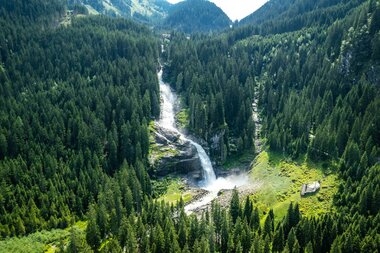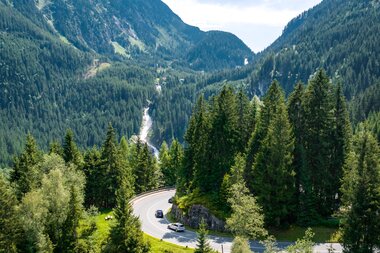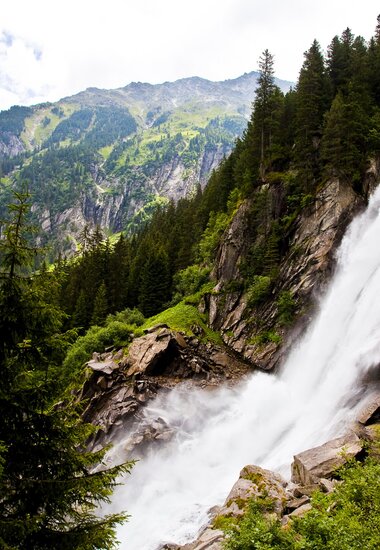30 million years ago: How everything began ...
Some 30 million years ago the Central Alps in Europe began to arch up. The collision of the African and Eurasian tectonic plates released incredible forces: The many layers laying on top of each other, which had formed over several ages, unfolded and rose up. This gave rise to the so-called “Hohe Tauern window”, through which geologists can trace the formation and composition of the Alps by looking at the various layers. Also part of this geologically special zone is the precipice over which the Krimmler Ache River and the Krimml Waterfalls plunge down into the valley.
From unnoticed nature to backdrop for romantic painters

Until the end of the eighteenth century, Krimml was a small insignificant village at the “end of the world”. From here, the only way to Tirol led across the arduous Krimmler Tauern. The trail across the mountain pass was already known for centuries, not least as it served freight haulers and traders as the shortest way from Salzburg to Italy. The Krimml Waterfalls, however, led an unnoticed existence. Until eventually the budding enthusiasm for nature of the Romantic era discovered their charm. Waterfalls, village and alpine surroundings formed the perfect backdrop for travelling painters. Because in the painting during the Romantic era, nature, which until then had only been depicted as a backdrop or accompanying theme in pictures and paintings, now itself moved into focus of artistic interest. The natural wonder became a star!
Alpine fascination of the romantic era & first tourism in Krimml

At the turn of the nineteenth century the Krimml Waterfalls were already well known among romantics and alpinists with a passion for the mountains. Even his “Serene Highness” Archduke Johann visited the “famous Krimml Waterfalls” in the year 1829. In 1842 the first stairway to the lower of the three waterfalls was built. Wealthy tourists who had made the journey by horse-drawn carriage and romantic painters could now – protected from the mist of the waterfall by a shelter – observe and marvel at the impressive deluge of water to their heart’s content. The journey to the massive waterfalls was expensive and thus reserved only for a lucky few. The rest had to be content with pictures and descriptions.
The railway brings tourism to Krimml
For a long time, Mittersill was the final stop for those travelling by train. Only at the end of the nineteenth century the Pinzgau train – today Pinzgauer Lokalbahn – was opened, with which guests could travel the remaining 32 kilometres to Krimml. The accessibility by train, the construction of the hiking trail along the Krimml Waterfalls by the Austrian Alpine Club and the construction of inns and hotels ensured that tourism around the largest waterfalls in Europe quickly increased. The electricity industry, however, was successfully denied access to the waterfalls: In the year 1958, Krimmler Achental and the waterfalls were given protected status. Since the year 1984, the falls as part of the Hohe Tauern National Park became permanently untouchable.
Want to see the Krimml Waterfalls with your own eyes? Learn more about the element of water in the Krimml Worlds of Water? Then see the fastest way of getting here and everything you need to know about prices and opening hours of the Krimml Worlds of Water!

